|
|
1. Test and Measurement
Technological advancements in the last two decades have given us a variety of useful measurement tools, and most manufacturers of these instruments provide specialized training on their use. This section will examine some principles of test and measurement that are common to virtually all measurement systems. If the measurer understands the principles of measurement, then most any of the mainstream measurement tools will suffice for the collection and evaluation of data.
The most important prerequisite to performing meaningful sound system measurements is that the measurer has a solid understanding of the basics of audio and acoustics. The question "How do I perform a measurement?" can be answered much more easily than "What should I measure?" This section will touch on both, but readers will find their measurements skills will relate directly to their understanding of the basic physics of sound and the factors that produce good sound quality.
The whole of this book will provide much of the required information.
1.1 Why Test?
Sound systems must be tested to assure that all components are functioning properly. The test and measurement process can be subdivided into two major categories-electrical tests and acoustical tests. Electrical testing mainly involves voltage and impedance measurements made at component interfaces. Current can also be measured, but since the setup is inherently more complex it is usually calculated from knowledge of the voltage and impedance using Ohm's Law. Acoustical tests are more complex by nature, but share the same fundamentals as electrical tests in that some time varying quantity (usually pressure) is being measured. The main difference between electrical and acoustical testing is that the interpretation of the latter must deal with the complexities of 3D space, not just amplitude versus time at one point in a circuit. In this section we will define a loudspeaker system as a number of components intentionally combined to produce a system that may then be referred to as a loudspeaker. For example, a woofer, dome tweeter, and crossover network are individual components, but can be combined to form a loudspeaker system. Testing usually involves the measurement of systems, although a system might have to be dissected to fully characterize the response of each component.
2. Electrical Testing
There are numerous electrical tests that can be per formed on sound system components in the laboratory.
The measurement system must have specifications that exceed the equipment being measured. Field testing need not be as comprehensive and the tests can be per formed with less sophisticated instrumentation. The purpose for electrical field testing includes:
1. To determine if all system components are operating properly.
2. To diagnose electrical problems in the system, which are usually manifested by some form of distortion.
3. To establish a proper gain structure.
Electrical measurements can aid greatly in establishing the proper gain structure of the sound system.
Electrical test instruments that the author feels are essential to the audio technician include:
• ac voltmeter.
• ac millivoltmeter.
• Oscilloscope.
• Impedance meter.
• Signal generator.
• Polarity test set.
It is important to note that most audio products have on-board metering and/or indicators that may suffice for setting levels, making measurements with stand-alone meters unnecessary. Voltmeters and impedance meters are often only necessary for troubleshooting a nonworking system, or checking the accuracy and calibration of the on-board metering.
There are a number of currently available instruments designed specifically for audio professionals that perform all of the functions listed. These instruments need to have bandwidths that cover the audible spectrum. Many general purpose meters are designed primarily for ac power circuits and do not fit the wide bandwidth requirement.
More information on electrical testing is included in the section on gain structure. The remainder of this section will be devoted to the acoustical tests that are required to characterize loudspeakers and rooms.
3. Acoustical Testing
The bulk of acoustical measurement and analysis today is being performed by instrumentation that includes or is controlled by a personal computer. Many excellent systems are available, and the would-be measurer should select the one that best fits their specific needs.
As with loudspeakers, there is no clear-cut best choice or one size fits all instrument. Fortunately an under standing of the principles of operating one analyzer can usually be applied to another after a short indoctrination period. Measurement systems are like rental cars-you know what features are there; you just need to find them. In this section I will attempt to provide a sufficient overview of the various approaches to allow the reader to investigate and select a tool to meet his or her measurement needs and budget. The acoustical field testing of sound reinforcement systems mainly involves measurements of the sound pressure fluctuations produced by a loudspeaker(s) at various locations in the space. Microphone positions are selected based on the information that is needed. This could be the on-axis position of a loudspeaker for system alignment purposes, or a listener seat for measuring the clarity or intelligibility of the system. Measurements must be made to properly calibrate the system, which can include loudspeaker crossover settings, equalization, and the setting of signal delays. Acoustic waveforms are complex by nature, making them difficult to describe with one number readings for anything other than broadband level.
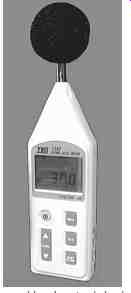
FIG. 1. A sound level meter is basically a voltmeter that operates in the
acoustic domain. Galaxy Audio.

FIG. 2. A plot of sound level versus time is the most complete way to record
the level of an event. Courtesy
3.1 Sound Level Measurements
Sound level measurements are fundamental to all types of audio work. Unfortunately, the question "How loud is it?" does not have a simple answer. Instruments can easily measure sound pressures, but there are many ways to describe the results in ways relevant to human perception. Sound pressures are usually measured at a discrete listener position. The sound pressure level may be displayed as is, integrated over a time interval, or frequency weighted by an appropriate filter. Fast meter response times produce information about peaks and transients in the program material, while slow response times yield data that correlates better with the perceived loudness and energy content of the sound.
A sound level meter consists of a pressure sensitive microphone, meter movement (or digital display), and some supporting circuitry, FIG. 1. It is used to observe the sound pressure on a moment-by-moment basis, with the pressure displayed as a level in decibels.
Few sounds will measure the same from one instant to the next. Complex sounds such as speech and music will vary dramatically, making their level difficult to describe without a graph of level versus time, FIG. 2.
A sound level meter is basically a voltmeter that operates in the acoustic domain.
Sound pressure measurements are converted into decibels ref. 0.00002 pascals. See Section 2, Fundamentals of Audio and Acoustics, for information about the decibel. Twenty micropascals are used as the reference because it is the threshold of pressure sensitivity for humans at midrange frequencies. Such measurements are referred to as sound pressure level or LP (level of sound pressure) measurements, with LP gaining acceptance among audio professionals because it is easily distinguished from LW (sound power level) and LI (sound intensity level) and a number of other LX metrics used to describe sound levels. Sound pressure level is measured at a single point (the microphone position).
Sound power measurements must consider all of the radiated sound from a device and sound intensity measurements must consider the sound power flowing through an area. Sound power and sound intensity measurements are usually performed by acoustical laboratories rather than in the field, so neither is considered in this section. All measurements described in this section will be measurements of sound pressures expressed as levels in dB ref. 0.00002 Pa.
Sound level measurements must usually be processed for the data to correlate with human perception. Humans do not hear all frequencies with equal sensitivity, and to complicate things further our response is dependent on the level that we are hearing.
The well-known Fletcher-Munson curves describe the frequency/level characteristics for an average listener, see Section 2. Sound level measurements are passed through weighting filters that make the meter "hear" with a response similar to a human. Each scale correlates with human hearing sensitivity at a different range of levels. For a sound level measurement to be meaningful, the weighting scale that was used must be indicated, in addition to the response time of the meter.
Here are some examples of meaningful (if not universally accepted) expressions of sound level:
• The system produced an LP = 100 dBA (slow response) at mix position.
• The peak sound level was LA = 115 dB at my seat.
• The average sound pressure level was 100 dBC at 30 ft.
• The loudspeaker produced a continuous LP of 100 dB at one meter (assumes no weighting used).
• The equivalent sound level LEQ was 90 dBA at the farthest seat.
Level specifications should be stated clearly enough to allow someone to repeat the test from the description given. Because of the large differences between the weighting scales, it is meaningless to specify a sound level without indicating the scale that was used. An event that produces an LP = 115 dB using a C scale may only measure as an LP = 95 dB using the A scale.
The measurement distance should also be specified (but rarely is). Probably all sound reinforcement systems produce an LP = 100 dB at some distance, but not all do so at the back row of the audience! Lpk is the level of the highest instantaneous peak in the measured time interval. Peaks are of interest because our sound system components must be able to pass them without clipping them. A peak that is clipped produces high levels of harmonic distortion that degrade sound quality. Also, clipping reduces the crest factor of the waveform, causing more heat to be generated in the loudspeaker causing premature failure. Humans are not extremely sensitive to the loudness of peaks because our auditory system integrates energy over time with regard to loudness. We are, unfortunately, susceptible to damage from peaks, so they should not be ignored.
Research suggests that it takes the brain about 35 ms to process sound information (frequency-dependent), which means that sound events closer together than this are blended together with regard to loudness. This is why your voice sounds louder in a small, hard room. It is also why the loudness of the vacuum cleaner varies from room to room. Short interval reflections are integrated with the direct sound by the ear/brain system.
Most sound level meters have slow and fast settings that change the response time of the meter. The slow setting of most meters indicates the approximate root-mean-square sound level. This is the effective level of the signal, and should correlate well with its perceived loudness.
A survey of audio practitioners on the Syn-Aud-Con e-mail discussion group revealed that most accept an LP = 95 dBA (slow response) as the maximum accept able sound level of a performance at any listener seat for a broad age group audience. The A weighting is used because it considers the sound level in the portion of the spectrum where humans are most easily annoyed and damaged. The slow response time allows the measurement to ignore short duration peaks in the program. A measurement of this type will not indicate true levels for low-frequency information, but it is normally the mid-frequency levels that are of interest.
There exist a number of ways to quantify sound levels that are measured over time. They include:
• LPK-the maximum instantaneous peak recorded during the span.
• LEQ-the equivalent level (the integrated energy over a specified time interval).
• LN-where L is the level exceeded N percent of the time.
• LDEN-a special scale that weights the gathered sound levels based on the time of day. DEN stands for day-evening-night.
• DOSE-a measure of the total sound exposure.
A variety of instruments are available to measure sound pressure levels, ranging from the simple sound level meter (SLM) to sophisticated data-logging equipment. SLMs are useful for making quick checks of sound levels. Most have at least an A- and C-weighting scale, and some have octave band filters that allow band-limited measurements. A useful feature on an SLM is an output jack that allows access to the measured data in the form of an ac voltage. Software applications are available that can log the meter's response versus time and display the results in various ways. A plot of sound level versus time is the most complete way to record the level of an event. FIG. 2 is such a measurement. Note that a start time and stop time are specified. Such measurements usually provide statistical summaries for the recorded data. An increasing number of venues monitor the levels of performing acts in this manner due to growing concerns over litigation about hearing damage to patrons. SLMs vary dramatically in price, depending on quality and accuracy.
All sound level meters provide accurate indications for relative levels. For absolute level measurements a calibrator must be used to calibrate the measurement system. Many PC-based measurement systems have routines that automate the calibration process. The calibrator is placed on the microphone, FIG. 3, and the calibrator level (usually 94 or 114 dB ref. 20 µPa) is entered into a data field. The measurement tool now has a true level to use as a reference for displaying measured data.
Noise criteria ratings provide a one-number specification for allowable levels of ambient noise. Sound level measurements are performed in octave bands, and the results are plotted on the chart shown in FIG. 4.
The NC rating is read on the right vertical axis. Note that the NC curve is frequency-weighted. It permits an increased level of low-frequency noise, but becomes more stringent at higher frequencies. A sound system specification should include an NC rating for the space, since excessive ambient noise will reduce system clarity and require additional acoustic gain. This must be considered when designing the sound system. Instrumentation is available to automate noise criteria measurements.

FIG. 3. A calibrator must be fitted with a disc to provide a snug fit to
the microphone. Most microphone manufacturers can provide the d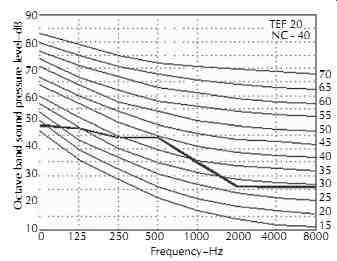 isc.
isc.
FIG. 4. A noise criteria specification should accompany a sound system specification.
3.1.1 Conclusion
Stated sound level measurements are often so ambiguous as to become meaningless. When stating a sound level, it is important to indicate:
1. The sound pressure level.
2. Any weighting scale used.
3. Meter response time (fast, slow or other).
4. The distance or location at which the measurement was made.
5. The type of program measured (i.e., music, speech, ambient noise).
Some correct examples:
• "The house system produced 90 dBA-Slow in section C for broadband program."
• "The monitor system produced 105 dBA-Slow at the performer's head position for broadband program."
• "The ambient noise with room empty was NC-35 with HVAC running." In short, if you read the number and have to request clarification then sufficient information has not been given. As you can see, one-number SPL ratings are rarely useful.
All sound technicians should own a sound level meter, and many can justify investment in more elaborate systems that provide statistics on the measured sound levels. From a practical perspective, it is a worth while endeavor to train one's self to recognize various sound levels without a meter, if for no other reason than to find an exit in a venue where excessive levels exist.
3.2 Detailed Sound Measurements
The response of a loudspeaker or room must be measured with appropriate frequency resolution to be characterized. It is also important for the measurer to understand what the appropriate response should be. If the same criteria were applied to a loudspeaker as to an electronic component such as a mixer, the optimum response would be a flat (minimal variation) magnitude and phase response at all frequencies within the required pass band of the system. In reality, we are usually testing loudspeakers to make sure that they are operating at their fullest potential. While flat magnitude and phase response are a noble objective, the physical reality is that we must often settle for far less in terms of accuracy. Notwithstanding, even with their inherent inaccuracies, many loudspeakers do an outstanding job of delivering speech or music to the audience. Part of the role of the measurer is to determine if the response of the loudspeaker or room is inhibiting the required system performance.
3.2.1 Sound Persistence in Enclosed Spaces
Sound system performance is greatly affected by the sound energy persistence in the listening space. One metric that is useful for describing this characteristic is the reverberation time, T30. The T30 is the time required for an interrupted steady-state sound source to decay to inaudibility. This will be about 60 dB of decay in most auditoriums with controlled ambient noise floors. The T30 designation comes from the practice of measuring 30 dB of decay and then doubling the time interval to get the time required for 60 dB of decay. A number of methods exist for determining the T30, ranging from simple listening tests to sophisticated analytical methods. FIG. 5 shows a simple gated-noise test that can provide sufficient accuracy for designing systems. The bursts for this test can be generated with a WAV editor.
Bursts of up to 5 seconds for each of eight octave bands should be generated. Octave band-limited noise is played into the space through a low directivity loud speaker. The noise is gated on for one second and off for 1 second. The room decay is evaluated during the off span. If it decays completely before the next burst, the T30 is less than one second. If not, the next burst should be on for 2 seconds and off for 2 seconds. The measurer simply keeps advancing to the next track until the room completely decays in the off span, FIGs. 6, 7, and 8. The advantages of this method include:
1. No sophisticated instrumentation is required.
2. The measurer is free to wander the space.
3. The nature of the decaying field can be judged.
4. A group can perform the measurement.
A test of this type is useful as a prelude to more sophisticated techniques.
FIG. 5. Level versus time plot of a one-octave band gated burst (2-second duration).
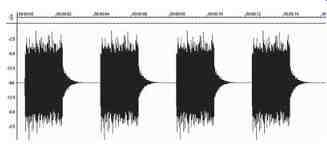
FIG. 6. A room with RT60 <2 seconds.
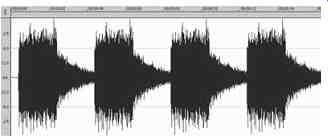
FIG. 7. A room with RT60 >2 seconds.
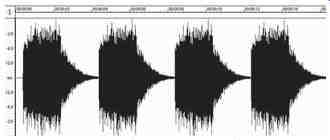
FIG. 8. A room with RT60 = 2 seconds.
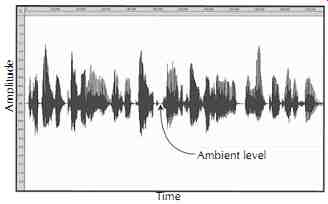
FIG. 9. Amplitude versus time plot of a male talker made in an anechoic environment.
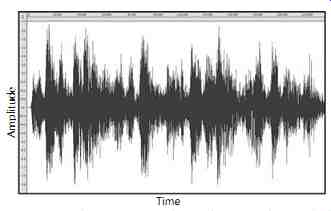
FIG. 10. The voice waveform after encoding with the room response.
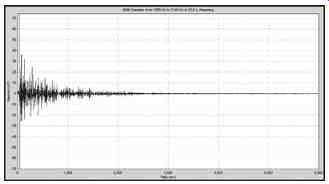
FIG. 11. The impulse response of the acoustic environment.
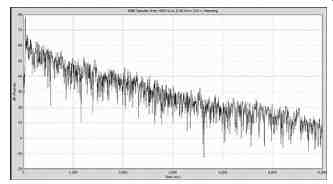
FIG. 12. The envelope-time curve (ETC) of the same environment. It can be
derived from the impulse response.
3.2.2 Amplitude versus Time
FIG. 9 shows an audio waveform displayed as amplitude versus time. This representation is especially meaningful to humans since it can represent the motion of the eardrum about its resting position. The waveform shown is of a male talker recorded in an anechoic (echo-free) environment. The 0 line represents the ambient (no signal) state of the medium being modulated. This would be ambient atmospheric pressure for an acoustical wave, or zero volts or a dc offset for an electrical waveform measured at the output of a system component.
FIG. 10 shows the same waveform, but this time played over a loudspeaker into a room and recorded.
The waveform has now been encoded (convolved) with the response of the loudspeaker and room. It will sound completely different than the anechoic version.
FIG. 11 shows an impulse response and FIG. 12 shows the envelope-time curve (ETC) of the loud speaker and room. It is essentially the difference between FIG. 9 and FIG. 10 that fully characterizes any effect that the loudspeaker or room has on the electrical signal fed to the loudspeaker and measured at that point in space. Most measurement systems attempt to measure the impulse response, since knowledge of the impulse response of a system allows its effect on any signal passing through it to be determined, assuming the system is linear and time invariant. This effect is called the transfer function of the system and includes both magnitude (level) and phase (timing) information for each frequency in the pass band. Both the loudspeaker and room can be considered filters that the energy must pass through en route to the listener.
Treating them as filters allows their responses to be measured and displayed, and provides an objective benchmark to evaluate their effect. It also opens loud speakers and rooms to evaluation by electrical network analysis methods, which are generally more widely known and better developed than acoustical measurement methods.
3.2.3 The Transfer Function
The effect that a filter has on a waveform is called its transfer function. A transfer function can be found by comparing the input signal and output signal of the filter. It matters little if the filter is an electronic component, loudspeaker, room, or listener. The time domain behavior of a system (impulse response) can be displayed in the frequency domain as a spectrum and phase (transfer function). Either the time or frequency description fully describes the filter. Knowledge of one allows the determination of the other. The mathematical map between the two representations is called a transform.
Transforms can be performed at amazingly fast speeds by computers. FIG. 13 shows a domain chart that provides a map between various representations of a system's response. The measurer must remember that the responses being measured and displayed on the analyzer are dependent on the test stimulus used to acquire the response. Appropriate stimuli must have adequate energy content over the pass band of the system being measured. In other words, we can't measure a sub woofer using a flute solo as a stimulus. With that criteria met, the response measured and displayed on the analyzer is independent of the program material that passes through a linear system. Pink noise and sine sweeps are common stimuli due to their broadband spectral content. In other words, the response of the system doesn't change relative to the nature of the program material. For a linear system, the transfer function is a summary that says, "If you put energy into this system, this is what will happen to it." The domain chart provides a map between various methods of displaying the system's response. The utility of this is that it allows measurement in either the time or frequency domain. The alternate view can be determined mathematically by use of a transform. This allows frequency information to be determined with a time domain measurement, and time information to be determined by a frequency domain measurement. This important inverse relationship between time and frequency can be exploited to yield many possible ways of measuring a system and/or displaying its response.
For instance, a noise immunity characteristic not attain able in the time domain may be attainable in the frequency domain. This information can then be viewed in the time domain by use of a transform. The Fourier Transform and its inverse are commonly employed for this purpose. Measurement programs like Arta can display the signal in either domain, FIG. 14.
3.3 Measurement Systems
Any useful measurement system must be able to extract the system response in the presence of noise. In some applications, the signal-to-noise requirements might actually determine the type of analysis that will be used.
Some of the simplest and most convenient tests have poor signal-to-noise performance, while some of the most complex and computationally demanding methods can measure under almost any conditions. The measurer must choose the type of analysis with these factors in mind. It is possible to acquire the impulse response of a filter without using an impulse. This is accomplished by feeding a known broadband stimulus into the filter and reacquiring it at the output. A complex comparison of the two signals (mathematical division) yields the transfer function, which is displayed in the frequency domain as a magnitude and phase or inverse-transformed for display in the time domain as an impulse response. The impulse response of a system answers the question, "If I feed a perfect impulse into this system, when will the energy exit the system?" A knowledge of "when" can characterize a system. After transformation, the spectrum or frequency response is displayed on a decibel scale. A phase plot shows the phase response of the device-under-test, and any phase shift versus frequency becomes apparent. If an impulse response is a measure of when, we might describe a frequency response as a measure of what. In other words, "If I input a broadband stimulus (all frequencies) into the system, what frequencies will be present at the output of the system and what will their phase relationship be?" A transfer function includes both magnitude and phase information.
3.3.1 Alternate Perspectives
The time and frequency views of a system's response are mutually exclusive. By definition the time period of a periodic event is (46-1) where,
T is time in seconds,
f is frequency in hertz.
Since time and frequency are reciprocals, a view of one excludes a view of the other. Frequency information cannot be observed on an impulse response plot, and time information can't be observed on a magnitude/phase plot. Any attempt to view both simultaneously will obscure some of the detail of both. Modern analyzers allow the measurer to switch between the time and frequency perspectives to extract information from the data.

FIG. 13. The domain chart provides a map between various representations
of a system response. Brüel and Kjaer.
3.4 Testing Methods
Compared to other components in the sound system, the basic design of loudspeakers and compression drivers has changed relatively little in the last 50 years. At over a half-century since their invention, we are still pushing air with pistons driven by voice coils suspended in magnetic fields. But the methods for measuring their performance have improved steadily since computers can now efficiently perform digital sampling and signal processing, and execute transforms in fractions of a second.
Extremely capable measurement systems are now accessible and affordable to even the smallest manufacturers and individual audio practitioners. A common attribute of systems suitable for loudspeaker testing is the ability to make reflection-free measurements indoors, without the need for an anechoic chamber.
Anechoic measurements in live spaces can be accomplished by the use of a time window that allows the analyzer to collect the direct field response of the loudspeaker while ignoring room reflections. Conceptually, a time window can be thought of as an accurate switch that can be closed as the desired waves pass the microphone and opened prior to the arrival of undesirable reflections from the environment. A number of implementations exist, each with its own set of advantages and drawbacks. The potential buyer must under stand the trade-offs and choose a system that offers the best set of compromises for the intended application.
Parameters of interest include signal-to-noise ratios, speed, resolution, and price.

FIG. 14. The FFT can be used to view the spectral content of a time domain
measurement, Arta 1.2.
3.4.1 FFT Measurements
The Fourier Transform is a mathematical filtering process that determines the spectral content of a time domain signal. The Fast Fourier Transform, or FFT, is a computationally efficient version of the same. Most modern measurement systems make use of the computer's ability to quickly perform the FFT on sampled data. The cousin to the FFT is the IFFT, or Inverse Fast Fourier Transform. As one might guess, the IFFT takes a frequency domain signal as its input and produces a time domain signal. The FFT and IFFT form the bedrock of modern measurement systems. Many fields out side of audio use the FFT to analyze time records for periodic activity, such as utility companies to find peak usage times or an investment firm to investigate cyclic stock market behavior. Analyzers that use the Fast Fourier Transform to determine the spectral content of a time-varying signal are collectively called FFTs. If a broadband stimulus is used, the FFT can show the spectral response of the device under test (DUT). One such stimulus is the unit impulse, a signal of theoretically infinite amplitude and infinitely small time duration.
The FFT of such a stimulus is a straight, horizontal line in the frequency domain.
The time-honored hand clap test of a room is a crude but useful form of impulse response. The hand clap is useful for casual observations, but more accurate and repeatable methods are usually required for serious audio work. The drawbacks of using impulsive stimuli to measure a sound system include:
1. Impulses can drive loudspeakers into nonlinear behavior.
2. Impulse responses have poor signal-to-noise ratios, since all of the energy enters the system at one time and is reacquired over a longer span of time along with the noise from the environment.
3. There is no way to create a perfect impulse, so there will always be some uncertainty as to whether the response characteristic is that of the system, the impulse, or some nonlinearity arising from impulsing a loudspeaker.
Even with its drawbacks, impulse testing can provide useful information about the response of a loudspeaker or room.
3.4.2 Dual-Channel FFT
When used for acoustic measurements, dual-channel FFT analyzers digitally sample the signal fed to the loudspeaker, and also digitally sample the acoustic signal from the loudspeaker at the output of a test micro phone. The signals are then compared by division, yielding the transfer function of the loudspeaker.
Dual-channel FFTs have the advantage of being able to use any broadband stimulus as a test signal. This advantage is offset somewhat by poorer signal-to-noise performance and stability than other types of measurement systems, but the performance is often adequate for many measurement chores. Pink noise and swept sines provide much better stability and noise immunity. It is a computationally intense method since both the input and output signal must be measured simultaneously and compared, often in real time. For a proper comparison to yield a loudspeaker transfer function, it is important that the signals being compared have the same level, and that any time offsets between the two signals be removed. Dual-channel FFT analyzers have set up routines that simplify the establishment of these conditions.
Portable computers have A/D converters as part of their on-board sound system, as well as a microprocessor to perform the FFT. With the appropriate software and sound system interface they form a powerful, low-cost and portable measurement platform.
3.4.3 Maximum-Length Sequence
The maximum-length sequence (MLS) is a pseudorandom noise test stimulus. The MLS overcomes some of the shortcomings of the dual-channel FFT, since it does not require that the input signal to the system be measured. A binary string (ones and zeros) is fed to the device under test while simultaneously being stored for future correlation with the loudspeaker response acquired by the test microphone. The pseudorandom sequence has a white spectrum (equal energy per Hz), and is exactly known and exactly repeatable. Comparing the input string with the string acquired by the test microphone yields the transfer function of the system.
The advantage of the MLS is its excellent noise immunity and fast measurement time, making it a favorite of loudspeaker designers. A disadvantage is that the noise like stimulus can be annoying, sometimes requiring that measurements be done after hours. The use of MLS has waned in recent years to log-swept sine measurements made on dual-channel FFT analyzers.
3.4.4 Time-Delay Spectrometry (TDS)
TDS is a fundamentally different method of measuring the transfer function of a system. Richard Heyser, a staff scientist at the Jet Propulsion Laboratories, invented the method. An anthology of Mr. Heyser's papers on TDS is available in the reference. Both the dual-channel FFT and MLS methods involve digital sampling of a broad band stimulus. TDS uses a method borrowed from the world of sonar, where a single-frequency sinusoidal "chirp" signal is fed to the system under test. The chirp slowly sweeps through the frequencies being measured, and is reacquired with a tracking filter by the TDS analyzer. The reacquired signal is then mixed with the out going signal, producing a series of sum and difference frequencies, each frequency corresponding to a different arrival time of sound at the microphone. The difference frequencies are transformed to the time domain with the appropriate transform, yielding the envelope-time Curve (ETC) of the system under test. TDS is based on the frequency domain, allowing the tracking filter to be tuned to the desired signal while ignoring signals outside of its bandwidth. TDS offers excellent noise immunity, allowing good data to be collected under near-impossible measurement conditions. Its downside is that good low-frequency resolution can be difficult to obtain with out extended measurement times, plus the correct selection of measurement parameters requires a knowledgeable user. In spite of this, it is a favorite among contractors and consultants, who must often perform sound system calibrations in the real world of air conditioners, vacuum cleaners, and building occupants.
While other measurement methods exist, the ones outlined above make up the majority of methods used for field and lab testing of loudspeakers and rooms. Used properly, any of the methods can provide accurate and repeatable measured data. Many audio professionals have several measurement platforms and exploit the strong points of each when measuring a sound system.
Next>>